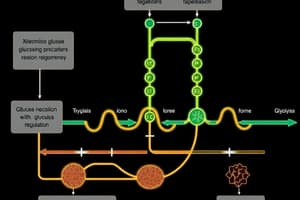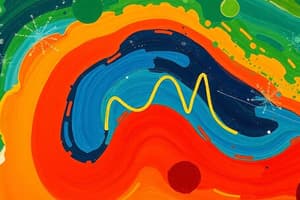Podcast
Questions and Answers
Which glucose transporter is primarily found in neurons?
Which glucose transporter is primarily found in neurons?
- GLUT-1
- GLUT-3 (correct)
- GLUT-4
- GLUT-2
What is the primary end product of glycolysis under aerobic conditions?
What is the primary end product of glycolysis under aerobic conditions?
- ATP
- Glucose
- Lactate
- Pyruvate (correct)
In which type of tissue does anaerobic glycolysis primarily occur?
In which type of tissue does anaerobic glycolysis primarily occur?
- Liver cells
- Skeletal muscle
- Adipose tissue
- Red blood cells (correct)
What mechanism allows glucose membrane transport in the renal tubules?
What mechanism allows glucose membrane transport in the renal tubules?
Which glucose transporter is characterized by its abundance in adipose tissue?
Which glucose transporter is characterized by its abundance in adipose tissue?
What is the primary outcome of anaerobic glycolysis per molecule of glucose?
What is the primary outcome of anaerobic glycolysis per molecule of glucose?
What role does glucokinase play in the metabolism of glucose?
What role does glucokinase play in the metabolism of glucose?
During aerobic glycolysis, how many molecules of NADH are produced per molecule of glucose?
During aerobic glycolysis, how many molecules of NADH are produced per molecule of glucose?
What effect does glucagon have on glycolysis?
What effect does glucagon have on glycolysis?
In terms of ATP production, what is the net yield from aerobic glycolysis when considering NADH conversion in the electron transport chain?
In terms of ATP production, what is the net yield from aerobic glycolysis when considering NADH conversion in the electron transport chain?
Flashcards
Glucose transport into cells
Glucose transport into cells
Glucose enters cells through facilitated diffusion (no energy needed) or active transport (needs energy).
Glycolysis
Glycolysis
The breakdown of glucose inside cells to produce energy in the form of ATP and other metabolic products.
Aerobic glycolysis
Aerobic glycolysis
Glucose breakdown that relies on oxygen and mitochondria to produce energy.
Anaerobic glycolysis
Anaerobic glycolysis
Signup and view all the flashcards
End product of aerobic glycolysis
End product of aerobic glycolysis
Signup and view all the flashcards
What is the role of Glucagon in glycolysis?
What is the role of Glucagon in glycolysis?
Signup and view all the flashcards
What is the role of Insulin in glycolysis?
What is the role of Insulin in glycolysis?
Signup and view all the flashcards
What is the difference between hexokinase and glucokinase?
What is the difference between hexokinase and glucokinase?
Signup and view all the flashcards
What is the energy yield of anaerobic glycolysis?
What is the energy yield of anaerobic glycolysis?
Signup and view all the flashcards
What is the energy yield of aerobic glycolysis?
What is the energy yield of aerobic glycolysis?
Signup and view all the flashcards
Study Notes
Lecture 19: Glycolysis
- Glycolysis is a metabolic pathway in the cytoplasm of cells. It breaks down glucose for energy (ATP) and intermediates for other metabolic processes.
- Specific objectives for the lecture include understanding the glycolytic pathway of glucose and the hormonal regulation of glycolysis.
- Glucose transport into cells happens via two mechanisms:
- Na+-independent facilitated diffusion transport (mediated by a family of 14 glucose transporters). Examples include GLUT-1 (abundant in erythrocytes and blood brain barrier), GLUT-2 (liver cells), GLUT-3 (neurons), and GLUT-4 (adipose and skeletal muscle). Insulin stimulates GLUT-4.
- Na+-monosaccharide co-transporter system (SGLT) requires energy and transports glucose against its concentration gradient in cells of the intestine, renal tubules, and choroid plexus.
- Aerobic glycolysis converts glucose to pyruvate in cells with mitochondria and adequate oxygen.
- Anaerobic glycolysis converts glucose to lactate without oxygen. This process generates ATP in tissues lacking mitochondria or those with insufficient oxygen (e.g., red blood cells).
- Important enzymes in glycolysis:
- Hexokinase: In most tissues, the phosphorylation of glucose. It has a high affinity (low Km) for glucose but low capacity (low Vmax).
- Glucokinase: In liver parenchymal cells and β cells of the pancreas. Acts as a glucose sensor, determining the threshold for insulin secretion in β cells and facilitating glucose phosphorylation in the liver during hyperglycemia (higher Km than hexokinase).
- PFK-1 (phospho-fructokinase-1): The most important control point and rate-limiting step of glycolysis. It is inhibited by ATP and citrate and activated by AMP.
- Pyruvate kinase: Catalyzes the conversion of phosphoenol pyruvate (PEP) to pyruvate, and in turn ATP formation.
- Anaerobic glycolysis produces two ATP per glucose, with no net production or consumption of NADH.
- Aerobic glycolysis produces 8 ATP per glucose molecule, due to 2 ATP directly, and 2NADH each contributing to 3 more ATPs via the electron transport chain.
- Hormonal regulation of glycolysis:
- Glucagon inhibits glycolysis by inhibiting key enzymes glucokinase, phosphofructokinase-1, and pyruvate kinase, mainly in liver cells.
- Insulin stimulates glycolysis by stimulating key enzymes.
- Pyruvate kinase deficiency can lead to hemolytic anemia due to reduced ATP production in red blood cells, affecting cell shape and causing phagocytosis.
- Deficiencies in glycolytic enzymes reduce glycolysis rate and ATP production, leading to anemia and red blood cell lysis.
Reference Books
- Biochemistry "Lippincott's Illustrated Reviews", 5th or 6th Edition(Champe, P. C., Harvey, R. A., & Ferrier, D. R., 2005)
- Textbook of biochemistry for medical students, 6th Edition (Vasudevan, D. M., Sreekumari, S., & Kannan, V., 2011)
Studying That Suits You
Use AI to generate personalized quizzes and flashcards to suit your learning preferences.




